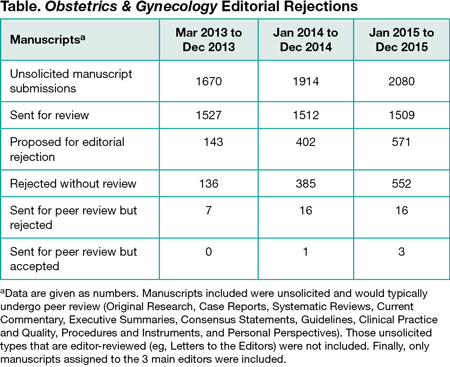Abstract
Editorial Rejections in Obstetrics & Gynecology
Randi Y. Zung,1 Rebecca S. Benner,1 Nancy C. Chescheir2
Objective
To describe the effectiveness of Obstetrics & Gynecology’s editorial rejection process and to assess whether the journal is eliminating potentially publishable manuscripts from consideration.
Design
Using retrospective data collected from administrative records maintained by the editorial office staff, manuscripts proposed for editorial rejection by the journal’s editors from March 2013 through December 2015 were reviewed. Per journal procedures, manuscripts proposed for editorial rejection were reviewed by a designated member of the editorial board to verify agreement with the proposed rejection. If the editorial board member disagreed, the manuscript was automatically sent for peer review. All proposed editorial rejections were reviewed a second time during a weekly conference by the editors for final approval prior to author notification. If there was disagreement between the editors, the manuscript was sent for peer review.
Results
Obstetrics & Gynecology received 5664 unsolicited manuscript submissions from March 2013 through December 2015; 1123 (19.8%) of these were Case Reports and 4541 (80.2%) were other unsolicited article types, such as Original Research. Of these submissions, 1116 (19.7%) were proposed for editorial rejection (Table
). Overall, the editorial board member disagreed with the editor’s proposed rejection for 43 manuscripts (3.9%), and these manuscripts were sent for peer review. Thirty-nine of the 43 manuscripts (90.7%) were ultimately rejected, requiring 70 peer reviews. Four of the 43 manuscripts (9.3%) were accepted following subsequent revision, requiring 15 peer reviews. Overall, 0.76% (43 of 5664) of submitted manuscripts were saved from outright editorial rejection, but only 0.07% (4 of 5664) were eventually published in the journal. The outright editorial rejection of 1116 manuscripts during this period saved Obstetrics & Gynecology from requesting 2825 peer reviews.
Conclusions
Manuscripts proposed for editorial rejection and saved by the editorial board veto are generally rejected following peer review. The editorial rejection process seems to identify submitted manuscripts that would not likely be accepted for publication; however, generalizability is limited owing to the small number of manuscripts examined. Furthermore, the absence of a comparison group does not allow the editors to assess for certain that this process is not eliminating potentially publishable manuscripts. The journal acknowledges that the editorial board member may be more likely to agree with the editors’ initial proposals, potentially making editorial rejections less likely to be saved by a veto.
1Obstetrics & Gynecology, Washington, DC, USA, rzung@greenjournal.org; 2Obstetrics & Gynecology, University of North Carolina–Chapel Hill, NC, USA
Conflict of Interest Disclosures:
None reported.

